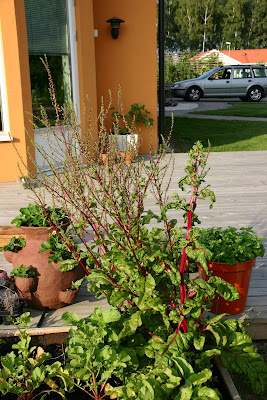Janne's birthday, this year again, and here is my (only?!) chance to bake a cake.
This time I wanted to have sugar paste to cover the cake, and I wanted to do sugar paste myself instead of purchasing it ready-made. Found a good recipe from a very trustworthy source of recipes, Bakglädje, which I personally highly recommend as it is an infinite source of tasteful stuff (ok, maybe not really infinite, but very tasteful indeed).
So this was the result from my baking activity:
From the far, the sugarpaste looks normal, but on a nearer look, it was rather "crumbled" and did not look very good.
This was probably due to the fact that I was not able to follow the recipe due to missing ingredients. Also the coloring was a real tough task. The color did not look near what I was aiming at. I wanted to have a "sun-orange" and a "orange-red" color but it rather turned into a "carrot orange" color and a "orange-pink" one. The green was not leave green either directly. What to do what to do... :O)
Anyway, I actually think the 3D-idea was rather neat, even though the implementation was as doubtful as usual.
As Janne is a real chocoholic, I decided to give in and make him a chocolate cake for once...
I personally love to fill the cake with fruit rather than only going for the classical mousse. I personally think it tastes healthier, but the "stability" of the cake is not top notch. Or maybe again, it is something I do wrong. But I think it was stable enough. In order to make the cake more stable even though it contains fruit, I normally put a string of icing, white chocolate chip icing to be specific, on the border of the cake for each layer and fill it with the wished fruit. Here, I used sliced bananas for the first layer and sliced strawberries for the second one.
I decided to complete the layers with a thin layer of white chocolate fluff at the top of each layer.
Unfortunately, the chocolate cake was so friable, it looked rather messy when sliced, but it did taste rather good anyways! And my little goldilocks seemed to appreciate anyways... :O)
This time I wanted to have sugar paste to cover the cake, and I wanted to do sugar paste myself instead of purchasing it ready-made. Found a good recipe from a very trustworthy source of recipes, Bakglädje, which I personally highly recommend as it is an infinite source of tasteful stuff (ok, maybe not really infinite, but very tasteful indeed).
So this was the result from my baking activity:
From the far, the sugarpaste looks normal, but on a nearer look, it was rather "crumbled" and did not look very good.
This was probably due to the fact that I was not able to follow the recipe due to missing ingredients. Also the coloring was a real tough task. The color did not look near what I was aiming at. I wanted to have a "sun-orange" and a "orange-red" color but it rather turned into a "carrot orange" color and a "orange-pink" one. The green was not leave green either directly. What to do what to do... :O)
Anyway, I actually think the 3D-idea was rather neat, even though the implementation was as doubtful as usual.
As Janne is a real chocoholic, I decided to give in and make him a chocolate cake for once...
I personally love to fill the cake with fruit rather than only going for the classical mousse. I personally think it tastes healthier, but the "stability" of the cake is not top notch. Or maybe again, it is something I do wrong. But I think it was stable enough. In order to make the cake more stable even though it contains fruit, I normally put a string of icing, white chocolate chip icing to be specific, on the border of the cake for each layer and fill it with the wished fruit. Here, I used sliced bananas for the first layer and sliced strawberries for the second one.
I decided to complete the layers with a thin layer of white chocolate fluff at the top of each layer.
Unfortunately, the chocolate cake was so friable, it looked rather messy when sliced, but it did taste rather good anyways! And my little goldilocks seemed to appreciate anyways... :O)












































